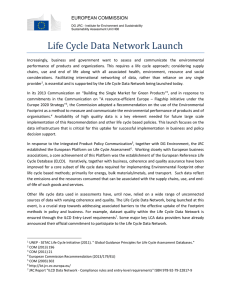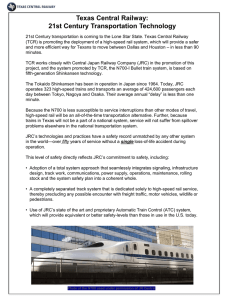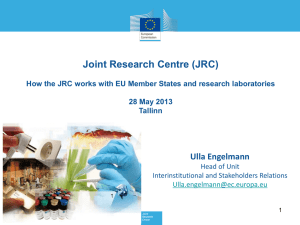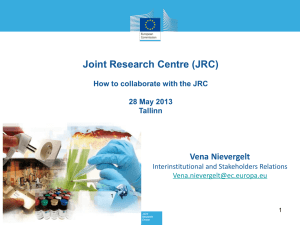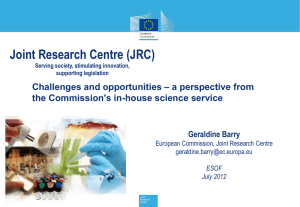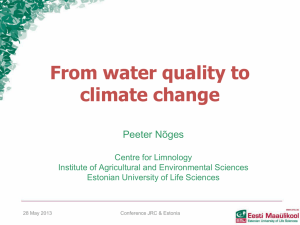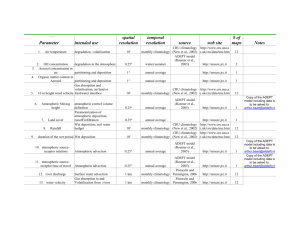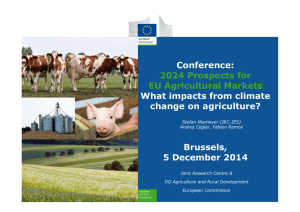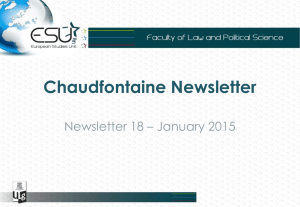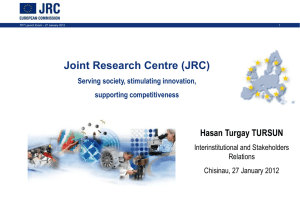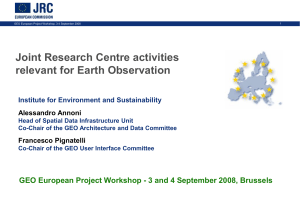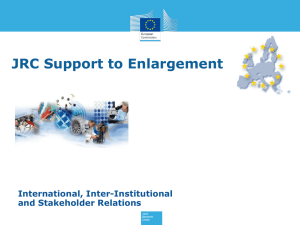JRC
advertisement
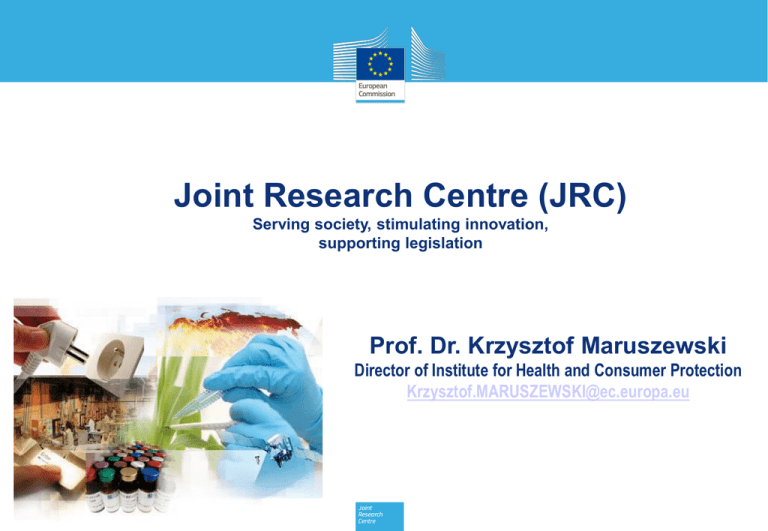
Joint Research Centre (JRC) Serving society, stimulating innovation, supporting legislation Prof. Dr. Krzysztof Maruszewski Director of Institute for Health and Consumer Protection Krzysztof.MARUSZEWSKI@ec.europa.eu 2 The JRC in the Commission President José Manuel Barroso … 27 Commission Members DG Environment DG Climate Action DG Agriculture and Rural Affairs DG Mobility and Transport Commissioner Geoghegan-Quinn Research, Innovation and Science Joint Research Centre (JRC) JRC Director-General Dominique Ristori DG Energy DG Research and Innovation 3 JRC’s Mission and Role … is to provide EU policies with independent, evidence-based scientific and technical support throughout the whole policy cycle. Direct research: JRC is the European Commission's in-house science service and the only DG executing direct research; providing science advice to EU policy. Serving society, stimulating innovation, supporting legislation 4 Quick Facts: Established 1957 • 7 institutes in 5 countries • 2,822 scientific and technical personnel • Over 1400 scientific publications in 2012 • Budget: €356 million annually, plus €62 million earned income 5 Key priorities • Economic and Monetary Union (EMU) • Internal market: growth, jobs and innovation • Low-carbon economy and resource efficiency (environment, climate change, energy, transport) • Agriculture and global food security • Public health, safety and security • Nuclear safety and security Providing the needed scientific support to the Europe 2020 policy priorities. 6 Cross-cutting activities • Policy analysis • Impact assessment • Foresight and horizon scanning • Economics • Both sectoral and integrated modelling • Knowledge Transfer • Education and Training Scientific support to the whole policy cycle 7 Policy anticipation Policy evaluation Effectiveness and impact assessment Ad-hoc policy support Agenda-setting Identification of emerging issues Policy formulation Expert advice JRC Policy implementation Crisis response Compliance checks Independent verification Anti-fraud measures Policy adoption Decision-making process Selection of programme options Examples of JRC activities: Supporting EU Policies 8 Policy anticipation Sustaining European Soil The JRC has developed robust databases supporting the European Soil Thematic Strategy and as a result created three soil atlases, unique collections of maps illustrating the varying patterns of different soil types occurring across Europe. One of the resulting outputs is the first ever European Atlas of Soil Biodiversity. Policy anticipation New developments in nanotechnology The JRC is working closely with policy makers providing science and research-based policy support for improving regulation of nanotechnology. It also hosts the largest repository of nano reference materials, has developed an internationally-available database containing test and measurement results used by the OECD, Member States and industry. In February 2011, the JRC released the world's first certified reference material for nanoparticles, based on industry-sourced materials. Policy anticipation INSPIRE: Harmonising environmental data worldwide The JRC is the technical and scientific coordinator of INSPIRE, the Infrastructure for Spatial Information in Europe, which provides the knowledge needed for mitigating natural and manmade hazards to make more efficient use of natural resources, to better protect the environment and to adapt to climate change. Examples of JRC activities: Supporting EU Policies 9 Policy implementation Making the EU's electricity grids smarter The JRC has identified and analysed the vulnerabilities of Member States’ electricity transmission systems for the implementation of a Directive on Critical European Infrastructures. Policy implementation Calculating greenhouse gas emissions from biofuel crops The JRC developed a new methodology to estimate changes in global greenhouse gas (GHG) emissions due to biofuel crops. This work underpinned the Commission Report required for the implementation of the Renewable Energy Directive. Policy implementation Detecting GMOs in food and feed The JRC provided the "Compendium of Reference Methods for GMO analysis", a reference report listing 79 GMO detection methods validated according to international standards in support of the Regulation on official food and feed controls. Examples of JRC activities: Supporting EU Policies 10 Ad-hoc policy support Nuclear forensics support to Member States The JRC supports safeguard authorities by providing environmental sampling and measurements techniques that are essential in the detection of non-declared nuclear activities. The JRC ‘clean lab’ is used for the measurement of uranium enrichment in particles founded in ‘swipes’ taken by IAEA or Euratom inspectors across the globe. Ad-hoc policy support Responding to crises GDACS (the Global Disaster Alert and Coordination System) provides near real-time alerts about natural disasters around the world. In addition, the JRC provided support to rescue operations by carrying out a rapid damage assessment based on the analysis of very high resolution satellite imagery. Ad-hoc policy support European Flood Alert System and European Forest Fire Information System JRC provides essential information to prepare for floods in Europe by complementing the information of national hydrological services with novel probabilistic flood forecasting information up to 10 days in advance. EFFIS comprehensively addresses forest fires in Europe providing EU level assessments from pre-fire to post-fire phases, thus supporting fire prevention, preparedness, fire fighting and post-fire evaluations. Examples of JRC activities: Supporting EU Policies 11 Policy anticipation Science for water The publication “Science for Water “aims to give a comprehensive overview of the JRC's work in relation to global water challenges. The report covers water quantity, quality, governance and innovation, the preservation of ecosystems and water-related hazards & climate change, providing a glimpse on how science and the JRC can contribute to find solutions in these fields. Science for the financial sector Ad-hoc policy support The JRC develops scientific models for the financial sector to reduce the probability of systematic crisis. The EC legislative proposal for minimum capital requirements in the banking sector (known as Basel III) and the EC legislative proposal on financial transactions were thoroughly tested using “SYMBOL”, a scientific model developed by the JRC. Policy anticipation TEFIS: Techno-economic Foresight for the Information Society The JRC supports Information Society Technology policies by generating prospective analyses and strategies related to the knowledge society. TEFIS is one such example where emerging trends in Information Society Technologies up to a 15-year time period will be studied, using integrated techno-economic foresight analyses leading to strategic priority-setting. Science support to policy: Horizon 2020 • Strengthening anticipation, foresight and horizon scanning • Expanding economic modelling capacity • Expanding socio-behavioural research • Providing evidence-based policy options, cost-benefit analysis and impact assessment • Strengthening science-based input to EU standardisation and legislative processes 12 A selection of JRC Scientific Facilities European Laboratory for Structural Assessment (ELSA) 13 Hot Cells Laboratory European Crisis Management Laboratory Fuel Cell Facility Nano-Materials Laboratory Vehicles Emissions Laboratory (VELA) European Reference Laboratory for Air Pollution (ERLAP) Van Der Graf Generator Examples of JRC publications •JRC Annual Report gives an overview of JRC activities. •Reference Reports are authoritative documents that represent a JRC-wide view on a subject for which the JRC is noted as expert. •Evaluation Reports promote the provision of fact-based judgement on the JRC's activities with a view to improving the design and management of the JRC •Newsletter is a bi-monthly publication with an overview of recent highlights •Brochures and reports 14 15 A Networked Organisation •1000+ partners: public and private organisations, institutions and expert groups •250 major networks worldwide: • • • • • • Cooperation and partnerships with key organisations Support to enlargement Training and mobility of researchers Access to scientific infrastructures Support to European Research Area policies Support to standardisation 15 IHCP – one of the 7 JRC Institutes 16 Institute for Health and Consumer Protection Policy Support Areas: ● Alternatives to Animal Testing ● Food and Consumer Products ● Genetically Modified Organisms ● Public Health ● Nanotechnology IHCP – one of the 7 JRC Institutes 17 Examples of activities Risk and benefit assessment ● Biocides, chemicals (including mixtures), nanomaterials, endocrine disrupters, dietary substances ● Integrated risk assessment methodologies ● Exposure assessment (noise, chemicals) Development and validation of sampling protocols and analytical tools for: ● Detection and quantification in Food and Consumer Products of: - Chemicals and other contaminants - Genetically modified organisms (GMOs) - Nanomaterials ● Toxicity testing of chemicals and nanomaterials with a strong focus on alternative-to-animal testing methods 17 IHCP – one of the 7 JRC Institutes 18 Reference Centres and Bureaus hosted by JRC-IHCP • 3 EURL European Reference Laboratories: Food Contact Materials, GM Food and Feed, Alternatives to Animal Testing • BEVABS - European Bureau for Wine, Alcohol and Spirit Drinks • ECB - European Chemicals Bureau (1993-2008) handed over to ECHA Impact • Coordination of National Reference Laboratories • Analytical controls are harmonised throughout Europe • Standardised methods delivering robust analytical results • Better implementation of legal limits • Reduced number of analyses in EU Member States • Safe food and consumer products for European consumers • Reducing number of animal tests by supporting Replacement, Reduction, Refinement ("3R") Serving society Stimulating innovation Supporting legislation Joint Research Centre (JRC) www.jrc.ec.europa.eu Contact: jrc-info@ec.europa.eu 19
